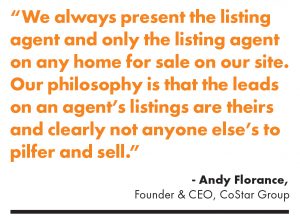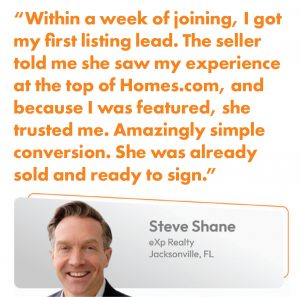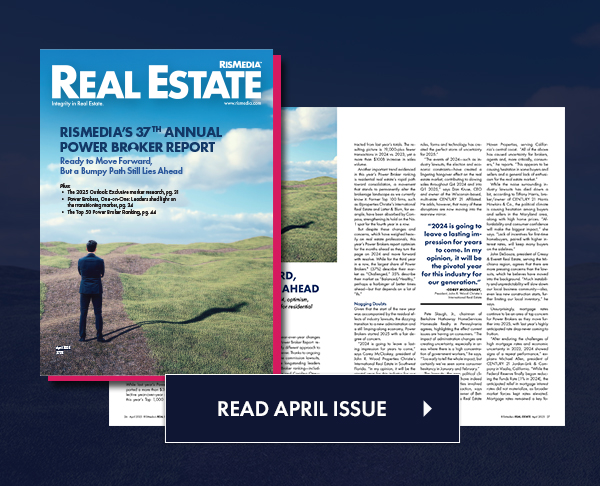Above, CoStar CEO Andy Florance
This time last year, Homes.com made big waves in residential real estate. The portal announced that it had achieved 100 million unique visitors to edge into the No. 2 spot behind Zillow. And that was before their massive marketing campaign kicked off.
One year later, Homes.com has clocked a series of jaw-dropping milestones, further strengthening its position within the industry, and distancing itself from the competition. Acquired by CoStar Group in 2020, the portal has been fueled by the operational and marketing power of its new parent company, as seen this past February when Homes.com and CoStar Group launched the largest advertising campaign the real estate industry has ever seen. The campaign kicked off with four star-studded ads in key Super Bowl time slots, which were then aired across major sporting and industry events and across every conceivable media outlet, from Hulu to YouTube, allowing the portal to skyrocket even further. As of press time, the Homes.com network reports 148M monthly unique visitors, surpassing Realtor.com®’s reported 74M monthly unique visitors, and gaining ground on Zillow’s coveted No. 1 spot.
While Homes.com attributes its success to “the best product and SEO/SEM talent in the industry,” CoStar Group Founder & CEO Andy Florance is also quick to cite its distinct business model, “Your Listing, Your Lead.” According to Florance, it is this philosophy, designed to keep the listing agent connected to their listing, that is at the crux of the portal’s meteoric rise.
As Florance notes, the Your Listing, Your Lead philosophy is particularly important in today’s fraught real estate landscape. “In this environment, where the world’s a little more sensitive and the landscape is relatively uncertain, we’re doing right by buyers and agents alike,” he says.
What Florance often finds wrong with most other real estate portals are their lead-diversion tactics: Consumers click on a listing, rightfully expecting to deal with the agent associated with it, only to be farmed out to unknown agents who have paid a premium to receive leads. Florance says consumers are “loud and clear” about the negative experience this creates and refers to these lead-diversion strategies as “the bad internet.”
“An unknowing consumer goes to Zillow or Realtor.com® and clicks ‘Contact Agent’ expecting to speak with the listing agent,” he explains. “Instead, the consumer is bombarded by spam calls, texts and emails from listing agents who know nothing about the property in question and may have no experience in the listing’s area. If one of these leads converts to a sale, the portal ultimately monetizes the transaction by taking 30% – 40% of the agents’ commission. This is clearly a bad experience for both agents and consumers.”


In contrast, the Your Listing, Your Lead model clearly identifies the listing agent, their photo and their brand on every listing, and all leads are sent directly to the listing agent. This, says Florance, is “the good internet.”
“We are committed to this model because it is a more honest and transparent way to do business,” he says. “We always present the listing agent and only the listing agent on any home for sale on our site. Our philosophy is that the leads on an agent’s listings are theirs and clearly not anyone else’s to pilfer and sell. This is not a new principle for us. CoStar Group has operated dozens of real estate websites for decades under the Your Listing, Your Lead philosophy because it is the right thing to do.”
This philosophy, adds Florance, is yielding tangible results. “Our agents across the board are winning about 50% more listings than their competitors,” he reports. “They’re winning a higher rate of these listings because they’re offering something of value to the seller. It is easy to hide behind the internet with shady tactics, but we are using it for good and allowing brokers to really build their brand.”
Business-building benefits aside, the Your Listing, Your Lead model may also play an important role in today’s commission-lawsuit environment, where residential real estate is under the microscope, and transparency at all levels of the transaction is more critical than ever.
“I almost think creates a little bit of reputational damage to the industry because (portals are) the entryway to the industry,” says Florance. “One hundred percent of buyers and sellers engage with real estate through these portals, and that’s their impression of the industry. So, it’s important that that impression is professional and harmonious with the interest of all the parties involved.”
Making the case for buyer agency
Given the prominence of the Your Listing, Your Lead philosophy, detractors often make the case that Homes.com caters to listing agents only. Florance says this couldn’t be further from the truth.
“Buyer agency thrives in an environment where the seller’s trusted agent answers the first call,” explains Florance. “When a prospective buyer reaches out to the listing agent on a home for sale, it is a potentially valuable lead no agent should be forced to give up. If that lead comes in and the buyer has a buyer’s agent, the listing agent who knows the house best can answer any questions the buyer has and then work with the buyer’s agent to sell the house.”

However, if the prospective buyer is not yet working with a buyer’s agent, there’s even more potential upside for the listing agent who can then earn a referral fee by sending the buyer to a real estate professional within their brokerage. The wealth is then spread further, Florance explains, with the referral-receiving agent more likely to work with the listing agent on future transactions. It is all part of the organically reciprocal nature of real estate transactions built upon trusting relationships among agents.
What’s more, the Homes.com model also lends itself perfectly to dual agency, where permitted. “Many times, the home the agent is listing is not the perfect fit for the buyer, so the listing agent can offer their expertise in the market to the buyer as a buyer’s agent and find the buyer a better house, while simultaneously earning commission,” says Florance.
All of these potential business-generating scenarios for both listing and buyer agents stem from the Your Listing, Your Lead approach, says Florance.
“The fact is that when portals like News Corp-owned Realtor.com® and Zillow unfairly steal leads from agents, they are stealing billions of dollars of potential commission money from hard-working agents,” he says.
Florance also sees the new post-Burnett, NAR-mandate environment as increasingly problematic for Homes.com’s competitors in the portal arena.
“Now that it has become very clear that buyers and sellers can negotiate commissions with their agents, portals like Realtor.com® and Zillow, who depend on referral fees earned from buyer agency leads, may see a decrease in revenue,” he says. “This change is seismic for the U.S. residential industry and is a tailwind for
Homes.com as we deliver high-quality leads to buyer and seller agents, but do not have a strict reliance upon buyer agency transactions as a revenue stream.”
The engine that makes it all work
A strong business model like Your Listing, Your Lead is nothing without a powerful engine behind it. That’s why CoStar Group committed the creative and financial resources necessary to make Homes.com an effective and lucrative business-building vehicle for real estate professionals.
With the agent top of mind, Homes.com introduced a membership program that offers an extensive suite of benefits for real estate professionals, including:
- Prominent listing placement at the top of the site’s home-search module and agent directory
- Featured positioning on Homes.com’s neighborhood and school pages
- Retargeted ads that follow interested consumers across the internet
- Featured emails
- A complimentary Matterport tour on each listing
 According to Homes.com, member agents win 50% more listings and gain 85% more exposure than non-members, 30 times the exposure of Zillow.
According to Homes.com, member agents win 50% more listings and gain 85% more exposure than non-members, 30 times the exposure of Zillow.
Homes.com has also made significant advancements on its product roadmap, launching the industry’s first, in-depth Neighborhood search.
“We took on the ambitious task of leveraging our 1,000-person content team to catalog each neighborhood in America,” says Florance. “Each neighborhood page on Homes.com highlights millions of beautiful photos and videos captured by our teams, alongside informative write-ups, relevant demographics and real estate information. Today, we are telling the story of America with over 22,000 neighborhoods available to explore on Homes.com.”
Homes.com also launched the industry’s first comprehensive school search, allowing users to view data on average test scores, graduation rates and school ratings to then find properties near the school or within its attendance zone.
“We have exclusive partnerships with Niche and GreatSchools, the two premier providers of school data in America, allowing us to develop pages for every school in the country,” says Florance. “We still have much left to do, but we are thrilled with our progress on product and content thus far.”
Unmatched marketing prowess
Despite its best efforts made to serve real estate agents at the highest level, Homes.com could fall short without the right consumer awareness. Thanks to the massive marketing support of CoStar Group, however, the portal is well on its way to becoming a household name.
According to third-party advertising tracking services Vivvix and Pathmatics, Homes.com’s marketing spend is essentially twice that of its competitors combined. And metrics show that the investment has been worth it so far. According to CoStar Group, at the time it acquired Homes.com, unaided awareness was at 4%; today, according to surveys conducted in September, unaided awareness is up to 33%—impressively rising from 28% in just one month, and in striking distance of Zillow’s 54%.
The portal attributes its brand awareness largely to what is referred to as the biggest marketing campaign the real estate industry has ever seen. This past February, Homes.com launched four ads during the Super Bowl, with many more aired in the following weeks. The high-profile ads, starring “Schitt’s Creek” star Dan Levy and “SNL” up-and-comer Heidi Gardner, were coupled with a boost in SEM spend, and additional ads were distributed through social media and YouTube.
Homes.com has kept the effort going since the February kickoff. In August, its media/advertising spend was more than $18M, and in September, the company launched a new product-oriented campaign during the Emmy Awards, featuring four new television spots and 20-plus new digital and social assets.
The overall goal of the gargantuan media push? To make Homes.com “inescapable.” So far, the plan seems to be working: More than 4,000 commercial placements have yielded over 1.5B impressions.
The massive consumer marketing campaign has caught the attention of real estate professionals as well. “As of our Q2 earnings call in July, over 10,000 agents had become members with net new bookings of over $55M,” says Florance. “For context, it took Apartments.com two years to achieve these same results—Homes.com accomplished this in just five months.”
At its core: Supporting real estate professionals
With the marketing and advertising commitment CoStar Group has made to vault Homes.com to prominence, it is not surprising that the portal has made marketing and branding real estate professionals a core part of its strategy.
According to Florance, agents put tens of thousands of hours of hard work into building their reputations as real estate experts who deliver the best results for their clients.
“The most important asset an agent has is their reputation,” he says. “What is the number one thing homebuyers and sellers looking for an agent use to determine a real estate agent is a trusted expert? It is the listing sign that shows someone else has entrusted that agent with selling their home. According to NAR, 100% of buyers are looking for their next home on the internet, so the visibility agents receive online is crucial.”
The lead diversion strategies of other portals, however, strip listing agents and their brokerages of critical branding.
“People wouldn’t voluntarily say, ‘take my name off my listings,’” says Florance. “How many of us, when you’re sending a mailer out of a new listing, take your name off the postcard and put Zillow’s name on it? How many of you would put a sign up and then put your competitor’s name on your listing sign? It’s illogical.”
 On the other hand, existing portals such as Zillow and Realtor.com®, have replaced an agent’s name with “email agent” or “contact agent.” The actual listing agent’s name is no longer front and center, making it increasingly harder for agents and brokers to build their brands. Florance goes so far as to say that in the traditional portal arena, brand identity has been stolen.
On the other hand, existing portals such as Zillow and Realtor.com®, have replaced an agent’s name with “email agent” or “contact agent.” The actual listing agent’s name is no longer front and center, making it increasingly harder for agents and brokers to build their brands. Florance goes so far as to say that in the traditional portal arena, brand identity has been stolen.
“In the residential real estate industry, the internet is obviously the most important marketing vehicle,” he explains. “The number of times the name of a brand has been stripped off is literally in the trillions over the last 10 years. To have the internet neutering the brands is nuts. It should be used to enhance the brand.”
Florance points to Keller Williams as an example of how brand is emphasized through the Homes.com model. On Homes.com, he says, the Keller Williams logo has been shown 45 billion times so far, over the course of 2024. “That includes not just on our site, but as we follow people on the New York Times, CNN or ESPN. It is across the whole spectrum.”
And when it comes to individual real estate professionals, says Florance, Homes.com has presented agent names to potential buyers and sellers 40 billion times so far this year.
The Homes.com strategy, Florance states, is using the internet the way it was intended to be used—as a marketing vehicle. “Every listing that you are marketing on Homes.com, you’re not being erased from your listing…the marketing that you’re getting, brand awareness, et cetera, all follows you throughout the process.”
Looking toward the future, Florance believes the Your Listing, Your Lead approach taken by Homes.com is a winning formula for all stakeholders involved in the real estate transaction: the brokerage, the agent and, most importantly, the consumer. Because of this, he believes Homes.com will only continue to separate itself from the pack, gaining further distance from its competitors in the portal space.
“In many ways, we don’t compete against Realtor.com® and Zillow,” says Florance. “They’re selling buyer agency leads as their primary thing. We are not. We are selling marketing tools for agents to win more listing
presentations.
“I think we’re in a unique spot given the internet has not delivered value to residential real estate the way it could and should,” he adds. “And I believe it will deliver a lot of value, and Homes.com is best positioned to capitalize on that.”
For more information, please visit https://www.homes.com/.












